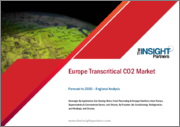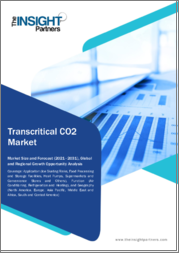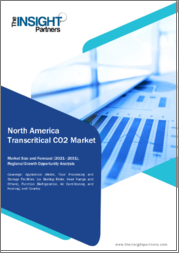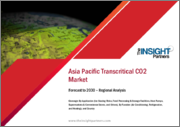
|
시장보고서
상품코드
1452504
유럽의 초임계 CO2 시장 전망(-2030년) - 지역별 분석 : 용도별, 기능별 시장 예측Europe Transcritical CO2 Market Forecast to 2030 - Regional Analysis - By Application and Function |
||||||
유럽의 초임계 CO2 시장은 2023년 251억 450만 달러에서 2030년 707억 4,737만 달러로 성장할 것으로 예상되며, 2023년부터 2030년까지 연평균 16.0%의 성장률을 나타낼 전망입니다.
슈퍼마켓과 편의점의 초임계 CO2 시스템 도입으로 유럽의 초임계 CO2 시장 활성화
슈퍼마켓과 편의점은 환경에 미치는 영향과 지속가능성에 대한 소비자의 엄격한 시선에 노출되는 경우가 많습니다. 초임계 CO2 시스템을 채택함으로써 소매업체는 지속가능성과 환경적 책임에 대한 약속을 홍보할 수 있으며, 브랜드 이미지를 개선하고 환경에 관심이 많은 소비자를 끌어들일 수 있습니다. 환경 친화적인 제품과 서비스에 대한 소비자 수요가 증가하고 있으며, CO2 시스템을 도입하는 소매업체는 시장에서 차별화를 통해 경쟁 우위를 확보할 수 있습니다. 또한 초임계 CO2 시스템은 다양한 환경 조건에 대한 유연성과 적응성을 가지고 있습니다. 아 임계 및 초임계 모드에서 효과적으로 작동할 수 있어 다양한 기후 조건에서도 최적의 성능을 발휘할 수 있습니다. 초임계 CO2 시스템의 설계는 다양한 냉장 부하, 매장 레이아웃 및 상품 진열 요구 사항과 같은 슈퍼마켓 및 편의점의 특정 요구 사항에 맞게 조정할 수 있습니다. 초임계 CO2 시스템의 유연성과 사용자 정의 옵션은 이러한 소매 환경에 적합합니다. 따라서 이러한 초임계 CO2 시스템의 장점은 시장을 더욱 주도하고 있습니다.
유럽의 CO2 시장 개요
유럽의 초임계 CO2 시스템 시장은 독일, 프랑스, 이탈리아, 영국, 러시아, 기타 유럽으로 구분됩니다. 유럽에서 초임계 CO2 시스템은 에너지 효율과 환경적 이점으로 인해 주목을 받고 있습니다. 이 시스템은 지구 온난화 가능성이 높은 기존의 하이드로플루오로카본(HFC) 냉매 대신 이산화탄소를 냉매로 사용합니다. 운송용 냉동, 산업용 냉동, 히트펌프, 슈퍼마켓, 편의점 및 기타 상업용 및 산업용 냉동 응용 분야에 사용할 수 있습니다. 초임계 CO2 시스템은 기존 냉매보다 임계 온도가 낮습니다. 또한 독성, 가연성 및 염소를 포함하지 않습니다. 이 시스템은 오존층 파괴 가능성이 무시할 수 있고, 지구 온난화도 무시할 수 있으며, 누출률이 낮습니다.
2022년 유럽위원회는 불소계 온실가스(F가스)와 오존층 파괴물질(ODS)의 사용을 엄격히 규제하는 두 가지 새로운 규정을 제안했습니다. 이러한 조치의 시행은 파리협정에 따라 지역의 기온 상승을 억제하는 데 큰 진전이 될 것입니다. 또한 F-가스 사용은 2050년까지 기후 중립을 달성하기 위해 유럽이 2030년까지 온실가스 배출량을 최소 55% 감축하는 데 도움이 될 수 있으며, 2050년까지 두 가지 효과를 합치면 EU의 온실가스 배출량을 4억 9,000만 톤(CO2 환산)을 줄일 수 있습니다. F-Gas 법과 HFC 단계적 폐지 계획으로 유럽의 초임계 CO2 시스템 시장은 크게 성장할 수 있습니다. 또한, 이 지역은 Tesco 및 Metro AG를 포함하여 초임계 CO2 시스템 기반 냉동 시스템으로 전환한 최종 사용자 조직이 가장 많은 지역이기도 합니다.
트럭 운전사 부족, 국경 폐쇄, 검역 요건 등 코로나19의 영향으로 유럽공급망은 혼란에 빠졌습니다. 이로 인해 각 기업은 제품의 유통기한을 유지할 수 없었고, 그 결과 시스템에서 저온 저장의 도입에 초점을 맞추게 되었습니다. 유럽 냉장 창고 및 물류 협회(ECSLA)에 따르면 유럽에는 수천 개의 냉장 창고가 있으며 유럽 전역에 6 만m3 이상의 상품 냉장 창고 용량이 있습니다. 유럽에서는 ECSLA가 현재 냉장창고의 용량과 그 확장을 관리하고 있습니다. 이러한 냉장창고 증가는 초임계 CO2 시스템에 대한 수요를 증가시키고 있으며, 향후 몇 년동안 시장 성장을 가속할 것입니다.
유럽의 초임계 CO2 시장 수익 및 2030년까지의 예측(금액)
유럽의 CO2 시장 세분화
유럽의 초임계 CO2 시장은 용도, 기능, 국가별로 구분됩니다.
용도별로 유럽의 초임계 CO2 시장은 아이스 스케이트장, 식품 가공 및 저장 시설, 히트펌프, 슈퍼마켓 및 편의점, 기타로 구분됩니다. 슈퍼마켓 및 편의점 부문이 2023년 유럽의 초임계 CO2 시장에서 가장 큰 점유율을 차지할 것으로 예상됩니다.
기능별로 보면 유럽 CO2 시장은 공조, 냉동, 난방으로 구분되며, 2023년 유럽의 초임계 CO2 시장에서 가장 큰 점유율을 차지한 분야는 냉동 분야였습니다.
국가별로 유럽의 초임계 CO2 시장은 독일, 프랑스, 이탈리아, 영국, 러시아, 기타 유럽으로 구분되며, 2023년 프랑스가 유럽의 초임계 CO2 시장을 독점할 것입니다.
TEKO Gesellschaft fur Kaltetechnik mbH, Baltimore Aircoil Co, BITZER Kuhlmaschinenbau GmbH, Carrier Global Corp, Danfoss AS, Emerson Electric Co, Panasonic Holdings Corp, Mayekawa Manufacturing Co Ltd는 유럽의 초임계 CO2 시장에서 사업을 전개하고 있는 주요 기업입니다.
목차
제1장 서론
제2장 요점
제3장 조사 방법
- 커버 범위
- 2차 조사
- 1차 조사
제4장 유럽의 초임계 CO2 시장 구도
- 시장 개요
- 유럽 PEST 분석
- 생태계 분석
- 전문가의 견해
제5장 유럽의 초임계 CO2 시장 - 주요 시장 역학
- 시장 성장 촉진요인
- 시장 성장 억제요인
- 시장 기회
- 향후 동향
- 성장 촉진요인과 억제요인 유럽 영향 분석
제6장 초임계 CO2 시장-유럽 시장 분석
- 임계 CO2 시장 개요
- 임계 CO2 시장 - 매출과 예측(-2030년)
제7장 유럽의 초임계 CO2 시장 분석 : 용도별
- 유럽의 초임계 CO2 시장 : 용도별(2022년, 2030년)
- 스케이트 링크
- 식품 가공 및 저장 시설
- 히트펌프
- 슈퍼마켓 및 편의점
- 기타
제8장 유럽의 초임계 CO2 시장 분석 : 기능별
- 유럽의 초임계 CO2 시장 : 기능별(2022년, 2030년)
- 공조
- 냉동
- 난방
제9장 유럽의 CO2 시장 : 국가별 분석
- 유럽의 초임계 CO2 시장 : 주요 국가별
- 독일의 초임계 CO2 시장 : 매출과 예측(-2030년)
- 프랑스의 초임계 CO2 시장 : 매출과 예측(-2030년)
- 이탈리아의 초임계 CO2 시장 : 매출과 예측(-2030년)
- 영국의 초임계 CO2 시장 : 매출과 예측(-2030년)
- 러시아의 초임계 CO2 시장 : 매출과 예측(-2030년)
- 기타 유럽의 초임계 CO2 시장 : 매출과 예측(-2030년)
제10장 업계 상황
- 시장 이니셔티브
- 신제품 개발
- 인수합병(M&A)
제11장 기업 개요
- TEKO Gesellschaft fur Kaltetechnik mbH
- Baltimore Aircoil Co
- BITZER Kuhlmaschinenbau GmbH
- Carrier Global Corp
- Danfoss AS
- Emerson Electric Co
- Panasonic Holdings Corp
- Mayekawa Manufacturing Co Ltd
제12장 부록
LSH 24.04.26The Europe transcritical CO2 market is expected to grow from US$ 25,104.50 million in 2023 to US$ 70,747.37 million by 2030. It is estimated to grow at a CAGR of 16.0% from 2023 to 2030.
Adoption of Transcritical CO2 Systems in Supermarkets and Convenience Stores Fuels the Europe Transcritical CO2 Market
Supermarkets and convenience stores often face consumer scrutiny regarding their environmental impact and sustainability practices. Adopting transcritical CO2 systems allows retailers to showcase their commitment to sustainability and environmental responsibility, improving their brand image and attracting eco-conscious consumers. Consumer demand for environmentally friendly products and services has been increasing, and retailers that embrace transcritical CO2 systems can differentiate themselves in the market and gain a competitive advantage. Moreover, transcritical CO2 systems offer operational flexibility and adaptability to varying ambient conditions. They can effectively operate in both subcritical and transcritical modes, allowing for optimal performance in different climates. The transcritical CO2 system design can be tailored to meet the specific needs of supermarkets and convenience stores, such as different refrigeration loads, store layouts, and product display requirements. The flexibility and customization options of transcritical CO2 systems make them suitable for these retail environments. Thus, all such advantages of transcritical CO2 systems are driving the market further.
Europe Transcritical CO2 Market Overview
The transcritical CO2 system market in Europe is segmented into Germany, France, Italy, the UK, Russia, and the Rest of Europe. In Europe, transcritical CO2 systems have gained a lot of attention due to their energy efficiency and environmental benefits. These systems use carbon dioxide as the refrigerant instead of the conventional hydrofluorocarbon (HFC) refrigerants with a high potential for global warming. It can be used for transport refrigeration, industrial refrigeration, heat pumps, supermarkets, convenience stores, and other commercial and industrial refrigeration applications. The transcritical CO2 system has a lower critical temperature than conventional refrigerants. Also, it is not toxic, flammable, and chlorinated. These systems have a negligible potential for ozone depletion, negligible global warming, and low leak rates.
In 2022, the European Commission proposed two new Regulations to strictly control the use of fluorinated greenhouse gases (F-gases) and ozone-depleting substances (ODS). The implementation of these measures would be a major step toward controlling the increase in regional temperatures in accordance with the Paris Agreement. The use of F-gas will also help Europe reduce greenhouse emissions by at least 55% by 2030 to achieve climate neutrality by 2050. By 2050, the combined effects of both ideas might reduce greenhouse gas emissions in the EU by 490 Mt (CO2 equivalent). Due to the F-Gas laws and HFC phase-out plan, the transcritical CO2 system market in Europe may have considerable growth. Additionally, the region has the greatest number of end-users organizations, including Tesco and Metro AG, that switched to refrigeration systems based on transcritical CO2 systems.
The effect of the COVID-19 pandemic, including the lack of truck drivers, border closures, and quarantine requirements, disrupted the supply chain in Europe. Thus, companies could not maintain product's shelf life, and hence the focus shifted to implementing cold storage in the system. According to the European Cold Storage & Logistics Association (ECSLA), Europe has thousands of cold storage units with a capacity of more than 60,000 m3 of commodities cold storage throughout Europe. In Europe, ECSLA manages the current cold storage capacity and its expansion. Thus, the rising number of cold storages increases the demand for transcritical CO2 systems, which will boost the market growth in the coming years.
Europe Transcritical CO2 Market Revenue and Forecast to 2030 (US$ Million)
Europe Transcritical CO2 Market Segmentation
The Europe transcritical CO2 market is segmented into application, function, and country.
Based on application, the Europe transcritical CO2 market is segmented into ice skating rinks, food processing & storage facilities, heat pumps, supermarkets & convenience stores, and others. The supermarkets and convenience stores segment held the largest share of the Europe transcritical CO2 market in 2023.
Based on function, the Europe transcritical CO2 market is segmented into air conditioning, refrigeration, and heating. The refrigeration segment held the largest share of the Europe transcritical CO2 market in 2023.
Based on country, the Europe transcritical CO2 market is segmented int o the Germany, France, Italy, the UK, Russia, and the Rest of Europe. France dominated the Europe transcritical CO2 market in 2023.
TEKO Gesellschaft fur Kaltetechnik mbH, Baltimore Aircoil Co, BITZER Kuhlmaschinenbau GmbH, Carrier Global Corp, Danfoss AS, Emerson Electric Co, Panasonic Holdings Corp, and Mayekawa Manufacturing Co Ltd are some of the leading companies operating in the Europe transcritical CO2 market.
Table Of Contents
1. Introduction
- 1.1 Study Scope
- 1.2 The Insight Partners Research Report Guidance
- 1.3 Market Segmentation
2. Key Takeaways
3. Research Methodology
- 3.1 Coverage
- 3.2 Secondary Research
- 3.3 Primary Research
4. Europe Transcritical CO2 Market Landscape
- 4.1 Market Overview
- 4.2 Europe PEST Analysis
- 4.3 Ecosystem Analysis
- 4.4 Expert Opinion
5. Europe Transcritical CO2 Market - Key Market Dynamics
- 5.1 Market Drivers
- 5.1.1 Sustainable Cooling and Refrigeration Solutions
- 5.1.2 Adoption of Transcritical CO2 Systems in Supermarkets and Convenience Stores
- 5.2 Market Restraints
- 5.2.1 Higher Upfront Cost of Installing Transcritical CO2 System
- 5.3 Market Opportunities
- 5.3.1 Adverse Impact of High Global Warming Potential Refrigerants
- 5.4 Future Trends
- 5.4.1 Growing Adoption of Integrated Transcritical CO2 Systems
- 5.5 Europe Impact Analysis of Drivers and Restraints
6. Transcritical CO2 Market - Europe market Analysis
- 6.1 Transcritical CO2 Market Overview
- 6.2 Transcritical CO2 Market - Revenue and Forecast to 2030 (US$ Million)
7. Europe Transcritical CO2 Market Analysis - By Application
- 7.1 Overview
- 7.2 Europe Transcritical CO2 Market, By Application (2022 and 2030)
- 7.3 Ice Skating Rinks
- 7.3.1 Overview
- 7.3.2 Ice Skating Rinks: Europe Transcritical CO2 Market - Revenue, and Forecast to 2030 (US$ Million)
- 7.4 Food Processing & Storage Facilities
- 7.4.1 Overview
- 7.4.2 Food Processing & Storage Facilities: Europe Transcritical CO2 Market - Revenue, and Forecast to 2030 (US$ Million)
- 7.5 Heat Pumps
- 7.5.1 Overview
- 7.5.2 Heat Pumps: Europe Transcritical CO2 Market - Revenue, and Forecast to 2030 (US$ Million)
- 7.6 Supermarkets & Convenience Stores
- 7.6.1 Overview
- 7.6.2 Supermarkets & Convenience Stores: Europe Transcritical CO2 Market - Revenue, and Forecast to 2030 (US$ Million)
- 7.7 Others
- 7.7.1 Overview
- 7.7.2 Others: Europe Transcritical CO2 Market - Revenue, and Forecast to 2030 (US$ Million)
8. Europe Transcritical CO2 Market Analysis - By Function
- 8.1 Overview
- 8.2 Europe Transcritical CO2 Market, By Function (2022 and 2030)
- 8.3 Air Conditioning
- 8.3.1 Overview
- 8.3.2 Air Conditioning: Europe Transcritical CO2 Market - Revenue, and Forecast to 2030 (US$ Million)
- 8.4 Refrigeration
- 8.4.1 Overview
- 8.4.2 Refrigeration: Europe Transcritical CO2 Market - Revenue, and Forecast to 2030 (US$ Million)
- 8.5 Heating
- 8.5.1 Overview
- 8.5.2 Heating: Europe Transcritical CO2 Market - Revenue, and Forecast to 2030 (US$ Million)
9. Europe Transcritical CO2 Market- Country Analysis
- 9.1 Overview
- 9.1.1 Europe: Transcritical CO2 Market, by Key Country
- 9.1.1.1 Germany: Transcritical CO2 Market- Revenue and Forecast to 2030 (US$ Million)
- 9.1.1.1.1 Germany: Transcritical CO2 Market, By Application
- 9.1.1.1.2 Germany: Transcritical CO2 Market, By Function Type
- 9.1.1.2 France: Transcritical CO2 Market- Revenue and Forecast to 2030 (US$ Million)
- 9.1.1.2.1 France: Transcritical CO2 Market, By Application
- 9.1.1.2.2 France: Transcritical CO2 Market, By Function Type
- 9.1.1.3 Italy: Transcritical CO2 Market- Revenue and Forecast to 2030 (US$ Million)
- 9.1.1.3.1 Italy: Transcritical CO2 Market, By Application
- 9.1.1.3.2 Italy: Transcritical CO2 Market, By Function Type
- 9.1.1.4 UK: Transcritical CO2 Market- Revenue and Forecast to 2030 (US$ Million)
- 9.1.1.4.1 UK: Transcritical CO2 Market, By Application
- 9.1.1.4.2 UK: Transcritical CO2 Market, By Function Type
- 9.1.1.5 Russia: Transcritical CO2 Market- Revenue and Forecast to 2030 (US$ Million)
- 9.1.1.5.1 Russia: Transcritical CO2 Market, By Application
- 9.1.1.5.2 Russia: Transcritical CO2 Market, By Function Type
- 9.1.1.6 Rest of Europe: Transcritical CO2 Market- Revenue and Forecast to 2030 (US$ Million)
- 9.1.1.6.1 Rest of Europe: Transcritical CO2 Market, By Application
- 9.1.1.6.2 Rest of Europe: Transcritical CO2 Market, By Function Type
- 9.1.1.1 Germany: Transcritical CO2 Market- Revenue and Forecast to 2030 (US$ Million)
- 9.1.1 Europe: Transcritical CO2 Market, by Key Country
10. Industry Landscape
- 10.1 Overview
- 10.2 Market Initiative
- 10.3 New Product Development
- 10.4 Merger and Acquisition
11. Company Profiles
- 11.1 TEKO Gesellschaft fur Kaltetechnik mbH
- 11.1.1 Key Facts
- 11.1.2 Business Description
- 11.1.3 Products and Services
- 11.1.4 Financial Overview
- 11.1.5 SWOT Analysis
- 11.1.6 Key Developments
- 11.2 Baltimore Aircoil Co
- 11.2.1 Key Facts
- 11.2.2 Business Description
- 11.2.3 Products and Services
- 11.2.4 Financial Overview
- 11.2.5 SWOT Analysis
- 11.2.6 Key Developments
- 11.3 BITZER Kuhlmaschinenbau GmbH
- 11.3.1 Key Facts
- 11.3.2 Business Description
- 11.3.3 Products and Services
- 11.3.4 Financial Overview
- 11.3.5 SWOT Analysis
- 11.3.6 Key Developments
- 11.4 Carrier Global Corp
- 11.4.1 Key Facts
- 11.4.2 Business Description
- 11.4.3 Products and Services
- 11.4.4 Financial Overview
- 11.4.5 SWOT Analysis
- 11.4.6 Key Developments
- 11.5 Danfoss AS
- 11.5.1 Key Facts
- 11.5.2 Business Description
- 11.5.3 Products and Services
- 11.5.4 Financial Overview
- 11.5.5 SWOT Analysis
- 11.5.6 Key Developments
- 11.6 Emerson Electric Co
- 11.6.1 Key Facts
- 11.6.2 Business Description
- 11.6.3 Products and Services
- 11.6.4 Financial Overview
- 11.6.5 SWOT Analysis
- 11.6.6 Key Developments
- 11.7 Panasonic Holdings Corp
- 11.7.1 Key Facts
- 11.7.2 Business Description
- 11.7.3 Products and Services
- 11.7.4 Financial Overview
- 11.7.5 SWOT Analysis
- 11.7.6 Key Developments
- 11.8 Mayekawa Manufacturing Co Ltd
- 11.8.1 Key Facts
- 11.8.2 Business Description
- 11.8.3 Products and Services
- 11.8.4 Financial Overview
- 11.8.5 SWOT Analysis
- 11.8.6 Key Developments
12. Appendix
- 12.1 About The Insight Partners
- 12.2 Word Index



















